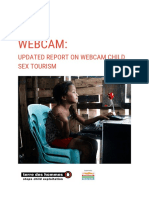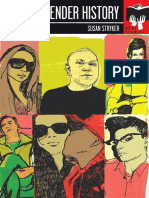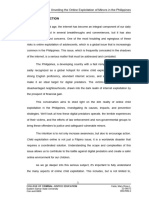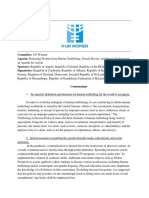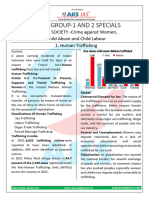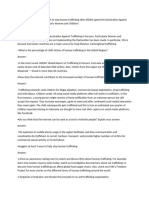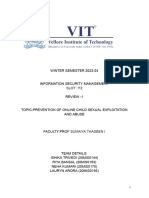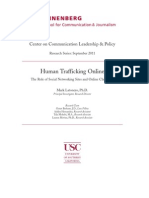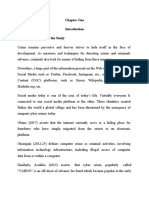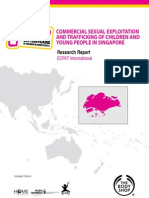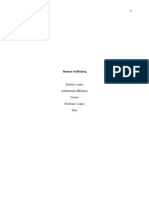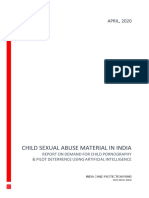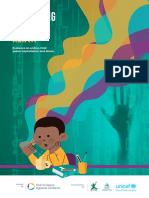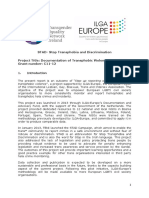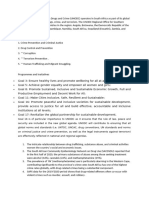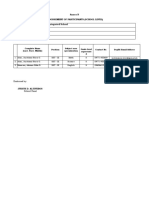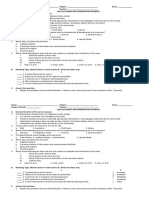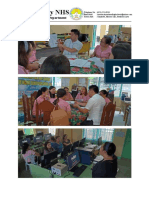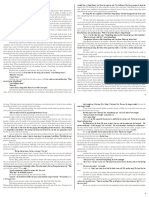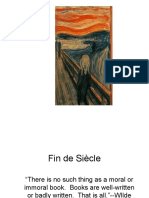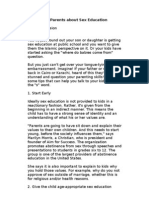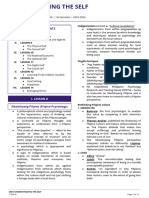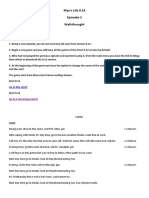0 ratings0% found this document useful (0 votes)
101 viewsHuman Trafficking
Human Trafficking
Uploaded by
Rizi Mae CodalHuman traffickers in Southeast Asia are increasingly using online tools like social media and mobile phones to recruit and exploit victims. The rapid growth of internet access and mobile phone usage in Asia has enabled traffickers to reach more potential victims. However, anti-trafficking organizations are also leveraging online technologies to identify and assist victims, through initiatives like mobile apps, data mapping of criminal networks, and public awareness campaigns involving private companies and law enforcement across borders. Meaningful multi-stakeholder partnerships are needed to effectively counter the growing threat of technology-enabled human trafficking in the region.
Copyright:
© All Rights Reserved
Available Formats
Download as DOCX, PDF, TXT or read online from Scribd
Human Trafficking
Human Trafficking
Uploaded by
Rizi Mae Codal0 ratings0% found this document useful (0 votes)
101 views1 pageHuman traffickers in Southeast Asia are increasingly using online tools like social media and mobile phones to recruit and exploit victims. The rapid growth of internet access and mobile phone usage in Asia has enabled traffickers to reach more potential victims. However, anti-trafficking organizations are also leveraging online technologies to identify and assist victims, through initiatives like mobile apps, data mapping of criminal networks, and public awareness campaigns involving private companies and law enforcement across borders. Meaningful multi-stakeholder partnerships are needed to effectively counter the growing threat of technology-enabled human trafficking in the region.
Original Title
human trafficking.docx
Copyright
© © All Rights Reserved
Available Formats
DOCX, PDF, TXT or read online from Scribd
Share this document
Did you find this document useful?
Is this content inappropriate?
Human traffickers in Southeast Asia are increasingly using online tools like social media and mobile phones to recruit and exploit victims. The rapid growth of internet access and mobile phone usage in Asia has enabled traffickers to reach more potential victims. However, anti-trafficking organizations are also leveraging online technologies to identify and assist victims, through initiatives like mobile apps, data mapping of criminal networks, and public awareness campaigns involving private companies and law enforcement across borders. Meaningful multi-stakeholder partnerships are needed to effectively counter the growing threat of technology-enabled human trafficking in the region.
Copyright:
© All Rights Reserved
Available Formats
Download as DOCX, PDF, TXT or read online from Scribd
Download as docx, pdf, or txt
0 ratings0% found this document useful (0 votes)
101 views1 pageHuman Trafficking
Human Trafficking
Uploaded by
Rizi Mae CodalHuman traffickers in Southeast Asia are increasingly using online tools like social media and mobile phones to recruit and exploit victims. The rapid growth of internet access and mobile phone usage in Asia has enabled traffickers to reach more potential victims. However, anti-trafficking organizations are also leveraging online technologies to identify and assist victims, through initiatives like mobile apps, data mapping of criminal networks, and public awareness campaigns involving private companies and law enforcement across borders. Meaningful multi-stakeholder partnerships are needed to effectively counter the growing threat of technology-enabled human trafficking in the region.
Copyright:
© All Rights Reserved
Available Formats
Download as DOCX, PDF, TXT or read online from Scribd
Download as docx, pdf, or txt
You are on page 1of 1
strategy of prevention, prosecution, protection and
Human trafficking in Asia going online
partnership.
3 May 2014
Authors: Alistair D. B. Cook and Caitríona H. Heinl, RSIS Along with the exponential increase in people accessing the
internet throughout Asia, digital activism will develop and
Human traffickers have an increasing number of targets grow. There have been several advances in anti-human
online in Southeast Asia. The ASEAN region has a growing trafficking responses, such as the US government’s pro-
population of over 600 million — and internet users have active policy of combatting human trafficking and corporate
doubled. Technology-facilitated trafficking is more diffuse social responsibility schemes. While most innovation in this
and adaptive than initially thought, but online tools can also field emanates from the United States and Europe, many
be creatively employed to counter cross-border trafficking. realise the need to adapt these technological advances to
the needs of people in Asia.
The explosion in mobile phone usage in the region facilitates
real-time communication and coordination by traffickers to The Virtual Global Taskforce brings law enforcement
recruit, harbour, transport, and provide higher numbers of agencies, NGOs and industry partners together to protect
victims for commercial sexual activity or forced labour. children from online child abuse. In 2012 Operation
Endeavour — an Australian, UK, US and Filipino law
This in turn broadens their horizon and increases their reach.
enforcement effort through the Virtual Global Taskforce —
The sharp incline in mobile broadband subscribers is also
used online tools such as data mapping to identify areas in
driving the explosion in global connectivity according to the
the Philippines where child abuse material was transmitted.
United Nations Office of Drugs and Crime (UNODC). Levels of
Operation Endeavour led to 29 international arrests, 11 of
cybercrime are increasing as individual and organised
which were in the Philippines — dismantling an organised
criminal groups exploit new opportunities without the need
crime group that had coordinated the live streaming of on-
for complex skills. For instance, online social media allows
demand child sexual abuse.
for new ways to facilitate people trafficking, distribution of
child abuse material, and new avenues for recruiting victims. In October 2013, the Taken Campaign launched the first
anti-trafficking mobile phone application to mark Anti-
Although ASEAN signed the Declaration Against Trafficking in
Slavery Day in London. In 2013, an anti-trafficking mobile
Persons, Particularly Women and Children, no significant
phone application was developed by RedLight Traffic in the
progress on implementing the Declaration has been made.
US. Along with the Polaris Project (a US-based NGO), the app
In particular, this is because East Asian countries are a major
provides users with potential trafficking indicators and red
source for long-distance, transregional trafficking. In the
flags to identify victims, a 20-minute training exercise to
most recent UNODC Global Report on Trafficking in Persons,
recognise trafficking, an anonymous way to report
East Asia and the Pacific account for nearly 40 per cent of
suspected cases to local authorities, and a sharing tool to
detected child victims. Also, victims from this region are the
establish a local community network against human
most geographically dispersed — found in more than 60
trafficking.
countries.
Also, the World Tourism Organisation (UNWTO), UNODC and
Trafficking networks seek children for illegal adoption,
UNESCO joined forces in March 2014 to promote a global
commercial sexual exploitation, drug trafficking and child
campaign, ‘Your Actions Count — Be a Responsible
labour. Children under 18 using social media platforms often
Traveller’. The campaign was launched with private sector
fall victim to traffickers. In the first instance, a young person
support from Marriott International and Sabre Holdings who
might receive a friend notification from an unknown person
will promote it to customers through their websites
but still accept the request. They increase exchanges, agree
(Travelocity and lastminute.com), online booking tools, their
to meet and after continued social media interaction they
TripCase mobile app and GetThere booking tool.
meet again. The child subsequently gets trafficked and this is
how an estimated one quarter of children reported missing These types of multi-stakeholder initiatives are sustainable
in Indonesia are thought to have met their captors on social and raise awareness — so are particularly significant for the
media platforms like Facebook. Asia-Pacific which is regarded as a source and destination
area for trafficked persons.
In February 2014, Chinese authorities rescued 382 babies
and arrested more than 1000 people suspected of buying Several multi-stakeholder approaches in the US and Europe
and selling young children online. This followed a six-month are using ICT to tackle human trafficking through the use of
operation in which authorities were made aware of a online petitions, data mapping and awareness-raising
website promoting private adoptions. Law enforcement activities. It is difficult for law enforcement authorities and
authorities subsequently uncovered an online black market governments to tackle this threat alone. Therefore,
that connected buyers and sellers over four websites, online meaningful collaboration between a range of stakeholders
forums and some 30 groups on a popular Chinese messaging and public-private cooperation are essential to fight
platform. trafficking, and counter criminals’ increasing use of ICT in
Southeast Asia.
Law enforcement is increasingly improving and developing
methods such as victim-identification databases and data
mining/analytics to improve forensic processes. However,
governments in the ASEAN region need a multi-pronged
strategy that focuses on prosecutions, raises awareness, and
involves the private sector. Singapore developed the
National Plan of Action for 2012–15 which identifies a ‘4P’
You might also like
- Marriage HacksDocument100 pagesMarriage Hacksaclew100% (1)
- Children of Webcam Updated ReportDocument25 pagesChildren of Webcam Updated ReportJohn J. MacasioNo ratings yet
- Susan Stryker - Transgender HistoryDocument209 pagesSusan Stryker - Transgender Historylukas100% (1)
- My Case Build UpDocument24 pagesMy Case Build UpFrancis AnireNo ratings yet
- Wdaht Campaign Concept (Osec) - As of 20 June 2019Document7 pagesWdaht Campaign Concept (Osec) - As of 20 June 2019Marlou NoyaNo ratings yet
- Human Trafficking in Asia Going OnlineDocument8 pagesHuman Trafficking in Asia Going OnlineARC brillantesNo ratings yet
- Manuscript Online Scams Information and PreventionDocument5 pagesManuscript Online Scams Information and PreventionNORMAN LOUIS CADALIGNo ratings yet
- Global Report On Trafficking in Persons 2020Document176 pagesGlobal Report On Trafficking in Persons 2020catolicoNo ratings yet
- Cyberspace Paradise For Paedophiles PDFDocument19 pagesCyberspace Paradise For Paedophiles PDFNayan Singh100% (1)
- Technology's Complicated Relationship With Human Trafficking - The Administration For Children and FamiliesDocument4 pagesTechnology's Complicated Relationship With Human Trafficking - The Administration For Children and Familiespratap81912No ratings yet
- Human Trafficking and Technology Trends Challenges and Opportunities WEB PDFDocument6 pagesHuman Trafficking and Technology Trends Challenges and Opportunities WEB PDFSijal zafarNo ratings yet
- Human trafficking-WPS OfficeDocument15 pagesHuman trafficking-WPS Officeerniecueva482No ratings yet
- Child Trafficking Uk DissertationDocument4 pagesChild Trafficking Uk DissertationWillYouWriteMyPaperForMeSingapore100% (1)
- The Future Battle Against Online MisinformationDocument3 pagesThe Future Battle Against Online MisinformationSaiful NaimNo ratings yet
- Trafficking in PersonsDocument8 pagesTrafficking in Personsovpatel007No ratings yet
- Sample Communique 2Document3 pagesSample Communique 2Divya SrinimmiNo ratings yet
- UNICEF PositionpaperDocument2 pagesUNICEF PositionpaperAlfa NovemberNo ratings yet
- Ruma ManashiDocument16 pagesRuma ManashiDeepansh TyagiNo ratings yet
- Ej 1157779Document10 pagesEj 1157779rikhotsonathaniel463No ratings yet
- Human Trafficking - APPSC SPECIALSDocument4 pagesHuman Trafficking - APPSC SPECIALSpromotionalmailing2No ratings yet
- A Case Study From The: PhilippinesDocument2 pagesA Case Study From The: PhilippinesNimNo ratings yet
- 2023 National Strategy For Child Exploitation Prevention Interdiction - CombinedDocument422 pages2023 National Strategy For Child Exploitation Prevention Interdiction - Combined7706567752No ratings yet
- MIL reportDocument2 pagesMIL reportkyles5984No ratings yet
- Sexual-Extortion Nonconsensual-Pornography Final 10-26-18Document46 pagesSexual-Extortion Nonconsensual-Pornography Final 10-26-18Rosa MelanoNo ratings yet
- Human Trafficking As A Cross Border Crime, The Impact of Internet TechnologyDocument22 pagesHuman Trafficking As A Cross Border Crime, The Impact of Internet TechnologyOkonkwo ChristianNo ratings yet
- Op Plan Human TraffickingDocument6 pagesOp Plan Human Traffickingstanleymudzamiri8No ratings yet
- The Menace of Child Trafficking and AbusDocument73 pagesThe Menace of Child Trafficking and Abusogeudemba16No ratings yet
- Cybersex Trafficking and Child VictimizationDocument5 pagesCybersex Trafficking and Child VictimizationQuinxNo ratings yet
- Child Exploitation in The Digital AgeDocument6 pagesChild Exploitation in The Digital Agesanjulav11No ratings yet
- ISM Review 1Document10 pagesISM Review 1riya28bansalNo ratings yet
- Analytical Paper Pol2088Document6 pagesAnalytical Paper Pol2088api-542961198No ratings yet
- USC Human Trafficking Online ReportDocument56 pagesUSC Human Trafficking Online ReportThe Berlin Turnpike: A True Story of Human Trafficking in AmericaNo ratings yet
- Child Pornography and Tourism-Briefing SheetDocument2 pagesChild Pornography and Tourism-Briefing SheetEquitable Tourism Options (EQUATIONS)100% (1)
- 12-Im Not For SaleDocument3 pages12-Im Not For Saleapi-265184167No ratings yet
- Cop Training 2023Document25 pagesCop Training 2023orishaba isaacNo ratings yet
- Project On Perception...Document19 pagesProject On Perception...Chidi EmmanuelNo ratings yet
- Research Lang MalakasDocument16 pagesResearch Lang MalakasCarl Anthony MendozaNo ratings yet
- The Extent of Child Trafficking and National Response in Ethiopia: A Quantitative StudyDocument13 pagesThe Extent of Child Trafficking and National Response in Ethiopia: A Quantitative StudyyouthimpactethNo ratings yet
- Sir Ipasa Mo Kami HahaDocument16 pagesSir Ipasa Mo Kami HahaCarl Anthony MendozaNo ratings yet
- Notes On OSAECDocument2 pagesNotes On OSAECHoney Mae de LeonNo ratings yet
- COMMERCIAL SEXUAL EXPLOITATION AND TRAFFICKING OF CHILDREN AND YOUNG PEOPLE IN SINGAPORE - 21 June 2011Document87 pagesCOMMERCIAL SEXUAL EXPLOITATION AND TRAFFICKING OF CHILDREN AND YOUNG PEOPLE IN SINGAPORE - 21 June 2011goodpaperNo ratings yet
- Human Trafficking: Student's Name Institutional Affiliation Course Professor's Name DateDocument7 pagesHuman Trafficking: Student's Name Institutional Affiliation Course Professor's Name DateBenjamin MuriithiNo ratings yet
- National Study On Online Sexual Abuse and Exploitation of Children in The Philippines - Executive SummaryDocument9 pagesNational Study On Online Sexual Abuse and Exploitation of Children in The Philippines - Executive SummaryEdward Daniel SimamoraNo ratings yet
- Discernment of High Trafficking Consitency Regions (Hotspot)Document18 pagesDiscernment of High Trafficking Consitency Regions (Hotspot)International Journal of Innovative Science and Research TechnologyNo ratings yet
- A New World To Worry AboutDocument6 pagesA New World To Worry AboutDanJalbunaNo ratings yet
- 017 Workshop: Technology and Human TraffickingDocument28 pages017 Workshop: Technology and Human TraffickingLittz MandumpalaNo ratings yet
- Discussion I. Gaps in Laws Relating To Child Internet Pornography Addressed by Republic Act 9775, Otherwise Known As The Anti-Child Pornography Act of 2009Document7 pagesDiscussion I. Gaps in Laws Relating To Child Internet Pornography Addressed by Republic Act 9775, Otherwise Known As The Anti-Child Pornography Act of 2009piptipaybNo ratings yet
- Full TextDocument152 pagesFull TextICSS.PSAKUNo ratings yet
- International Police Operations Against Online Child PornographyDocument6 pagesInternational Police Operations Against Online Child PornographyBozidar BanovicNo ratings yet
- Z2-061-Advising-9 28 24-10 8 24Document14 pagesZ2-061-Advising-9 28 24-10 8 24rk anagapNo ratings yet
- Human TraffickingDocument11 pagesHuman TraffickingRobert SNo ratings yet
- Child Sexual Abuse Material in India: APRIL, 2020Document11 pagesChild Sexual Abuse Material in India: APRIL, 2020Anany UpadhyayNo ratings yet
- 24 0408 k2p Csea-OnepagerDocument1 page24 0408 k2p Csea-Onepageramitibohre07No ratings yet
- DH Kenya ReportDocument102 pagesDH Kenya ReportCco UsgpNo ratings yet
- Cybercrime Report PDFDocument5 pagesCybercrime Report PDFSJ BatallerNo ratings yet
- In Modern BondageDocument221 pagesIn Modern BondageetishomeNo ratings yet
- Analysis On Children's RightDocument7 pagesAnalysis On Children's Rightpriyanjali banaNo ratings yet
- STAD-Stop Transphobia and DiscriminationDocument36 pagesSTAD-Stop Transphobia and DiscriminationMaria SaeedNo ratings yet
- GcmunDocument3 pagesGcmunshahprithvi01No ratings yet
- ACFrOgDj JZaz6S5zDXarAlbfgCalFUTrj8obVZxcbPeNGfn42HBKz0UuEqgdg6Xco1VNhGlH0JKFR3fa5D56WrO-zzcLcri7EVVZb S3b1sayR3GMGnmOGYoWW6i16-0evnUTQf6p64Lg7I8K3QDocument11 pagesACFrOgDj JZaz6S5zDXarAlbfgCalFUTrj8obVZxcbPeNGfn42HBKz0UuEqgdg6Xco1VNhGlH0JKFR3fa5D56WrO-zzcLcri7EVVZb S3b1sayR3GMGnmOGYoWW6i16-0evnUTQf6p64Lg7I8K3QL AcademyNo ratings yet
- Pathways White PaperDocument34 pagesPathways White Paperlibrairie esalamNo ratings yet
- School Lac Implementation Plan: Department of EducationDocument2 pagesSchool Lac Implementation Plan: Department of EducationRizi Mae CodalNo ratings yet
- Dr. Josilyn S. Solana, Ceso V: Dionisio C. ZamoraDocument1 pageDr. Josilyn S. Solana, Ceso V: Dionisio C. ZamoraRizi Mae CodalNo ratings yet
- Annex B Endorsement of Participants (School Level) Name of School Maria Clara Integrated School School ID 501050 Division Maasin City Region ViiiDocument2 pagesAnnex B Endorsement of Participants (School Level) Name of School Maria Clara Integrated School School ID 501050 Division Maasin City Region ViiiRizi Mae CodalNo ratings yet
- MEdia and Information Sources QuizDocument1 pageMEdia and Information Sources QuizRizi Mae Codal100% (5)
- Tungkung Langit and AlunsinaDocument1 pageTungkung Langit and AlunsinaRizi Mae CodalNo ratings yet
- To The Flowers of HeidelbergDocument2 pagesTo The Flowers of HeidelbergRizi Mae CodalNo ratings yet
- DramaDocument6 pagesDramaRizi Mae CodalNo ratings yet
- Module 1 - TNCTDocument14 pagesModule 1 - TNCTRizi Mae Codal80% (5)
- PF 2020 BookletDocument23 pagesPF 2020 BookletRizi Mae CodalNo ratings yet
- Maasin City NHS: Senior High School DepartmentDocument1 pageMaasin City NHS: Senior High School DepartmentRizi Mae CodalNo ratings yet
- Pre-Midterm Examination Schedule: Senior High School DepartmentDocument1 pagePre-Midterm Examination Schedule: Senior High School DepartmentRizi Mae CodalNo ratings yet
- A. A. A. A.: Read The Following Questions Carefully and Choose The Letter of The Correct AnswerDocument2 pagesA. A. A. A.: Read The Following Questions Carefully and Choose The Letter of The Correct AnswerRizi Mae CodalNo ratings yet
- The Repetition of Similar Vowel Sounds, Especially in A Line of PoetryDocument9 pagesThe Repetition of Similar Vowel Sounds, Especially in A Line of PoetryRizi Mae CodalNo ratings yet
- The FenceDocument2 pagesThe FenceRizi Mae CodalNo ratings yet
- Gaitskill Nice Girls HarpersDocument1 pageGaitskill Nice Girls HarpersbpattersNo ratings yet
- Employee 1 - Complaint Involving Kitty JungDocument10 pagesEmployee 1 - Complaint Involving Kitty JungNews4Fox11No ratings yet
- Women in VedasDocument4 pagesWomen in VedasAbdulaziz Khattak Abu FatimaNo ratings yet
- Doro Cat EssayDocument8 pagesDoro Cat EssayIustin AlexandruNo ratings yet
- Violence Against Women and Their ChildrenDocument3 pagesViolence Against Women and Their ChildrenDimpleNo ratings yet
- Fin de Siecle PowerpointDocument34 pagesFin de Siecle PowerpointLaura Struve100% (1)
- Fetishuri AlexandraDocument7 pagesFetishuri AlexandraAndra Dumitrache100% (1)
- Annexes A, G, I - Templates For BarangayDocument8 pagesAnnexes A, G, I - Templates For BarangayBarangay PoblacionNo ratings yet
- Safeguarding EssentialsDocument29 pagesSafeguarding Essentialsiradukunda2k22No ratings yet
- The Roles of Women in World LiteratureDocument3 pagesThe Roles of Women in World LiteratureMargarita ArnoldNo ratings yet
- 12 Tips For Parents About Sex EducationDocument8 pages12 Tips For Parents About Sex Educationنور حافظةNo ratings yet
- ST Dan SPPDDocument47 pagesST Dan SPPDViki Blues MalesNo ratings yet
- A Description of Karen Horney's Neo-Freudian Theory of PersonalityDocument3 pagesA Description of Karen Horney's Neo-Freudian Theory of PersonalityTamizharasi UdhayasuriyanNo ratings yet
- Rejuvenescimento VaginalDocument4 pagesRejuvenescimento VaginalIsteuria CristinaNo ratings yet
- Imasen vs. AlconDocument2 pagesImasen vs. AlconMonica FerilNo ratings yet
- CXC Social Studies QuestionnaireDocument3 pagesCXC Social Studies QuestionnaireTeddie BearNo ratings yet
- The Second Sex - Myth and RealityDocument32 pagesThe Second Sex - Myth and RealityRyan David CruzNo ratings yet
- The RubDocument3 pagesThe RubthischrishorneNo ratings yet
- Get Hard and Stay Hard - Destroy Premature Ejaculation, Last Longer in Bed & Become A Sexual Superman - Yes You CAN Do It - and It's Easier Than You Think! (PDFDrive)Document37 pagesGet Hard and Stay Hard - Destroy Premature Ejaculation, Last Longer in Bed & Become A Sexual Superman - Yes You CAN Do It - and It's Easier Than You Think! (PDFDrive)francisco100% (1)
- PD 101-Gender, Society With Personality Development: Activity No 2Document2 pagesPD 101-Gender, Society With Personality Development: Activity No 2Rocco WalksNo ratings yet
- RE 2 Modules 4 and 5Document25 pagesRE 2 Modules 4 and 5Lei LopezNo ratings yet
- Datin FMT PDF FreeDocument5 pagesDatin FMT PDF Freegfkjpsnd4sNo ratings yet
- 18BBL036 Case Brief - (Asgarali Pradhania V Emperor)Document2 pages18BBL036 Case Brief - (Asgarali Pradhania V Emperor)Rishabh Khandelwal0% (3)
- Naz Foundation V Govt of NCT DelhiDocument46 pagesNaz Foundation V Govt of NCT DelhiShreyaNo ratings yet
- Second Division Republic of The Philippines, G.R. No. 166676Document8 pagesSecond Division Republic of The Philippines, G.R. No. 166676brigetteNo ratings yet
- UTS ReviewerDocument19 pagesUTS ReviewerSamson, Arielle Cate D.No ratings yet
- Max's Life 0.14 Episodio 2 Walkthrought: Go To Rita ADocument5 pagesMax's Life 0.14 Episodio 2 Walkthrought: Go To Rita AMạnh Trần0% (1)
- Sexual Orientation QuestionnaireDocument3 pagesSexual Orientation QuestionnaireMarycynthiaNo ratings yet

